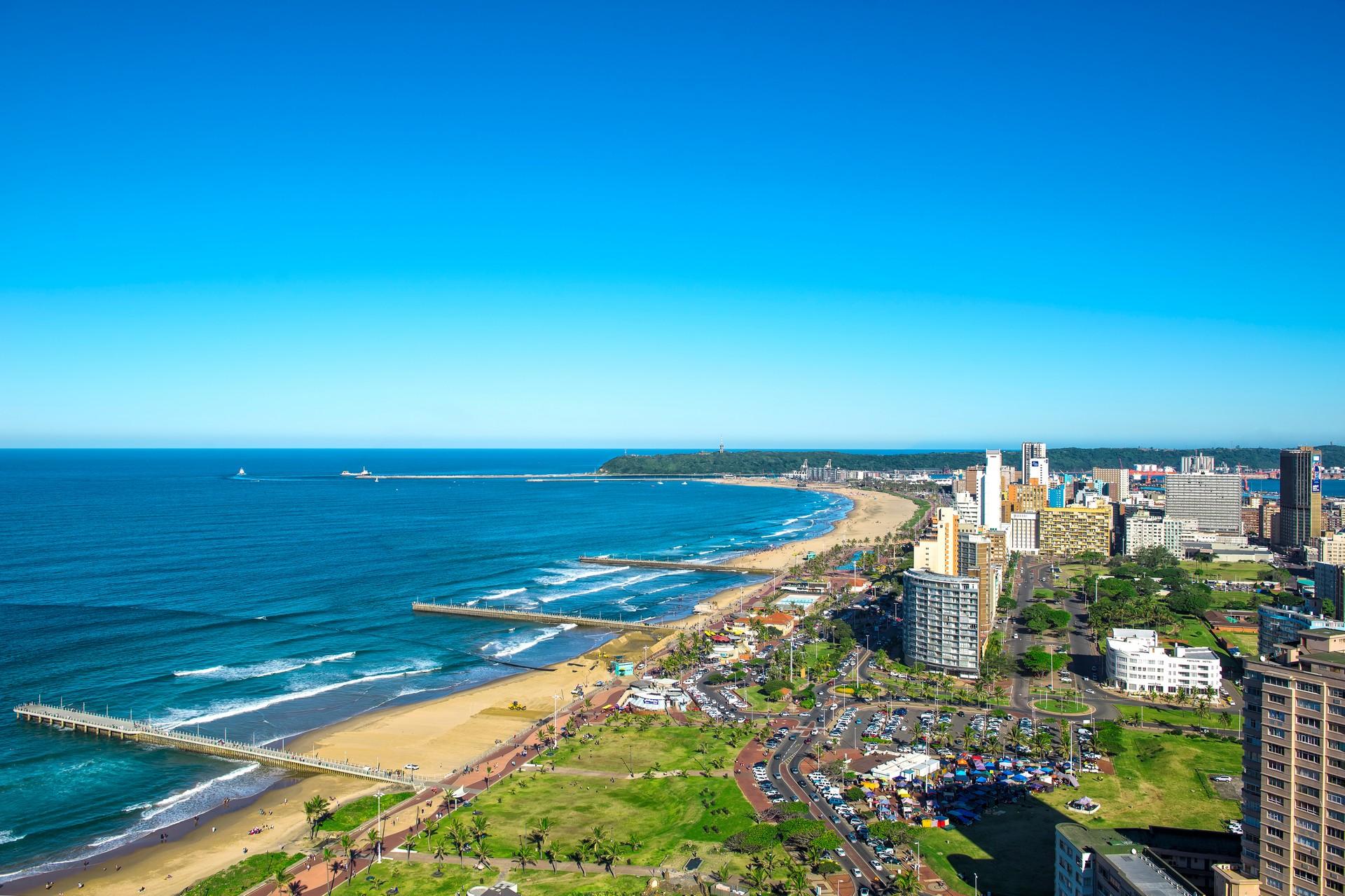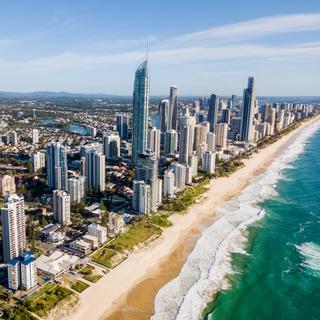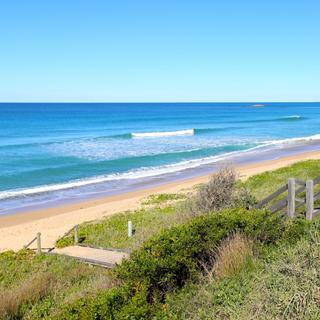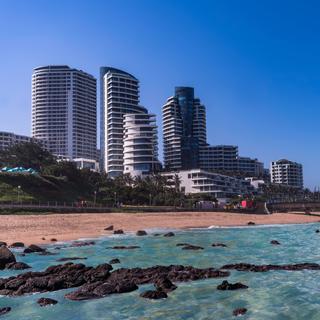
Durban weather and climate

Durban weather and climate
Day
23 °C
Night
13 °C
Sea
21 °C
Precipitation
42 mm
in month
Rainy days
4 days
in month
Daylight
11 hours
average
Sunshine
7 hours
average
Humidity
73 %
Weather charts for Durban
Destinations nearby and activities
Destinations nearby
Activities in Durban

Find more destinations like this
Destinations with similar weather to Durban
Other destinations in KwaZulu-Natal - South Africa
Closest cities for Durban
Weather overview for Durban
Weather overview
Nestled along the east coast of South Africa, Durban boasts a tropical climate that offers a delightful escape for visitors throughout the year. Daytime temperatures in this vibrant city are generally warm, with a peak at 28 °C (83 °F) in February, gently falling to a cooler 23 °C (73 °F) in the winter month of July. The balmy nights in Durban are coldest in July with a typical low of 11 °C (52 °F), while at their warmest in February, the mercury hits 21 °C (70 °F). If you’re looking to avoid rain, June is the driest month, averaging a scant 3 days of rainfall, while the month most likely to be laden with rain is December, offering up to 15 days of wet weather. With sea temperatures ranging from a refreshing 21 °C (70 °F) in August to a warm 26 °C (78 °F) in February, there’s a slice of seaside bliss awaiting you virtually any time you visit.
January weather
The ascent in daytime temperature is evident in Durban, registering at 28 °C (82 °F), accompanied by a sea temperature that keeps pace with the previous month, recorded at 25 °C (77 °F). The volume of rainfall hits a peak, topping off at 132 mm (5.20 in). The influx of visitors signals the start of the tourist season, while the apex of humidity reaches 80 %. The nocturnal temperature also continues its upward trajectory similar to the previous month, coming in at 21 °C (69 °F).
February weather
Durban welcomes the influx of tourists with the peak of daytime temperatures observed at 28 °C (83 °F), and sea temperatures also hitting their high points at 26 °C (78 °F). The decline in precipitation begins to appear, with a reduction recorded at 118 mm (4.65 in), while the decrease in the number of rainy days is also noted, settling at 13 days. The zenith of nocturnal temperatures is experienced as well, charting at 21 °C (70 °F).
March weather
The popular tourist season continues into March in Durban. A downward trend in the number of rainy days is marked, at 11 days, and the decline in rainfall is also prominent, documented at 109 mm (4.31 in). The commencement of the decline in daytime temperatures can be noticed, and a similar pattern is seen with night temperatures, now at 19 °C (67 °F).
April weather
April's traveler season in Durban observes a decrease in daytime temperatures, now at 26 °C (79 °F), while the decline in sea temperatures also becomes evident. The continuation of reduced rainfall is reflected in its volume at 68 mm (2.67 in), and the fall in the number of rainy days is equally represented, calculated at 7 days. The cooling trend in night temperatures is noticeable, currently at 17 °C (63 °F).
May weather
As we advance into May, the tourist season still persists with further reduction in sea temperatures, now at 24 °C (75 °F), and a similar drop in daytime temperatures, which are now at 25 °C (76 °F). The continuation of night temperature reduction is also evident, with the figure at 14 °C (58 °F). The slowing wind speeds reach their minimum for the year. The decline in rainfall volume can also be seen, at 37 mm (1.46 in).
June weather
The descent in daytime temperatures in Durban is noteworthy, now at 23 °C (73 °F), and the sea temperature also follows suit, registering at 22 °C (72 °F). The minimal number of rainy days is at its lowest, indirectly noted at 3 days, while the minimally recorded rainfall signifies the scarce precipitation, amounting to 25 mm (0.98 in). The downward trend in night temperatures continues comparably to the previous month, registering at 11 °C (53 °F). The dip in humidity is also pronounced, remaining at 70 %.
July weather
Durban's daily temperatures hit their lowest mark in July, with the reading at 23 °C (73 °F), while the continuation of the sea temperature decline is also observed, registering at 22 °C (71 °F). The increment in rainfall recommences, with the recorded figure at 42 mm (1.64 in). The onset of the dry season is announced. The minimum in night temperatures is also noted, with the number pegged at 11 °C (52 °F). The pinnacle of sun hours is experienced during days unobstructed by clouds.
August weather
The beginning of temperature rise during the day is detectable in August in Durban, with a registration of 23 °C (74 °F), while the sea temperature low is also evident, being 21 °C (70 °F). The upturn in the number of rainy days occurs simultaneously. The remainder of the dry season brings a progressive improvement. The initial increase in night temperatures is also noticeable, charted at 13 °C (55 °F).
September weather
The climbing trend in daytime temperatures persists into September in Durban, now at 24 °C (75 °F), and a concurrent rise in nocturnal temperatures is also observable, now at 15 °C (59 °F). The expansion in the number of rainy days is also noticeable, recorded at 8 days, while the start of the increase in rainfall volume is heralded, with the stated volume at 66 mm (2.58 in). The dwindling number of sun hours becomes apparent as clouds begin to obscure the sky more frequently.
October weather
The rise in the number of rainy days persists in Durban, with the statistic at 13 days, and a continued elevation in rainfall volume is also apparent, estimated at 100 mm (3.93 in). The sea temperature begins to inch upwards, with the new calculation at 22 °C (71 °F), while the ascension in night temperatures can also be discerned, illustrated at 17 °C (62 °F). The least amount of sun hours is reached this month, the measure read at 6 hours.
November weather
The day temperature marks the beginning of its upward movement in November in Durban, registering at 26 °C (78 °F), while the sea temperature continues to rise as well, shown at 23 °C (73 °F). The increase in the number of rainy days is also tracked, coming in at 14 days, while the rainfall amount shows a similar uptrend from the previous month, seen at 113 mm (4.45 in). The peak of wind speed is distinctive during this month, averaging at 4 m/s. The night temperature elevation is ongoing.
December weather
An upward trend in sea temperatures is observable in Durban during December, marked at 24 °C (75 °F), and this coincides with the rise in day temperatures as well, averaging at 27 °C (81 °F). The pinnacle of rainy days draws near, with the count at 15 days, and the hike in rainfall also corresponds with the previous month, the metric coming in at 122 mm (4.79 in). The first signs of increasing sun hours are noticeable, and the night temperatures see a similar uptrend, figured at 20 °C (68 °F).
FAQs
What kind of weather should I anticipate during my visit to Durban in January?
Visiting Durban in January, you can expect delightful weather, with daytime temperatures around a comfortable 28 °C (82 °F), and the sea's inviting warmth at 25 °C (77 °F). The nighttime temperatures remain agreeable, typically settling at 21 °C (69 °F).
Would you describe February as a particularly hot time to visit Durban?
Visiting Durban in February promises pleasantly warm conditions, with highs tapering at a delightful 28 °C (83 °F). It's lovely weather, typically comfortable for most visitors.
Does March in Durban fall within the rainy season?
March does not coincide with Durban's wet season. During this month, an average of 11 days sees rainfall.
In April, how prevalent are rainy days in Durban?
Expect roughly 7 days of rainfall in Durban during April, which translates to around 25 % of the month.
What temperatures might I expect during the day in Durban if I visit in May?
When visiting Durban in May, anticipate agreeable daily temperatures averaging 25 °C (76 °F), suitable for a diverse array of enjoyable outdoor activities.
During June, what amount of sunshine is usually available in Durban?
June typically brings about 7 hours of sunshine per day to Durban.
How strong are the winds typically in Durban during July?
July in Durban is characterized by a moderate breeze, with wind speeds averaging 3 m/s.
Is August considered a dry month in Durban?
Indeed, August is part of Durban's dry period, with a minimum of rainy days, specifically 4 days within the month.
How does Durban's climate transition as it moves from winter to spring?
With the onset of spring in September, Durban experiences a gradual increase in both day and night temperatures, while the rainy days become more frequent.
Can you expound on the humidity levels in Durban come October?
The humidity in Durban throughout October averages a slightly higher 77 %, generally comfortable for most people, bar those particularly sensitive to moisture in the air.
How do the nocturnal temperatures in Durban present themselves in November?
When the sun sets in November in Durban, expect the night air to average a mild 18 °C (65 °F), conducive to a host of nocturnal activities.
What's the current condition of the sea temperature in Durban come December?
In December, the inviting waters of Durban coast approach 24 °C (75 °F), offering a pleasantly warm swimming experience.







